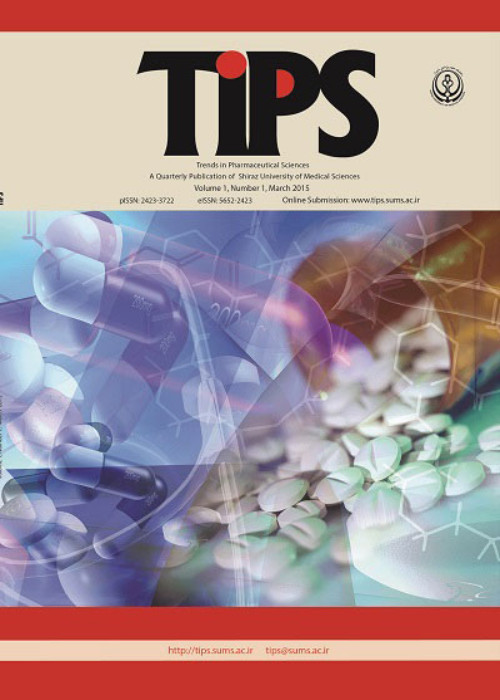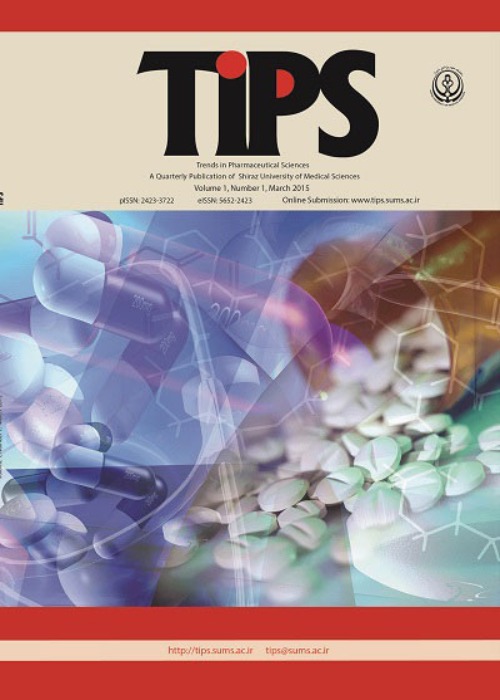فهرست مطالب

Trends in Pharmaceutical Sciences
Volume:9 Issue: 2, Jun 2023
- تاریخ انتشار: 1402/03/11
- تعداد عناوین: 7
-
Pages 93-104Acne vulgaris is a very common skin problem. Cutibacterium acnes (formerly Propionibacterium acnes), a common skin organism, is most notably recognized for its role in acne vulgaris. Standard oral and topical treatments have significant side effects including skin irritation, indigestion, and also, cause resistance to antibiotics. In current study, o/w creams based on ostrich and sesame fixed oils containing Mentha piperita, Origanum vulgare and Lavandula officinallis essential oils as active ingredients were developed. The results showed that using Cetomacrogol 1000/Cetostearyl alcohol (CSA) as emulsifier/co-emulsifier could produce stable o/w creams containing 10-30 % w/w of fixed oils with various consistencies. Long-term (room temperature/24 months), accelerated (40 °C/ three months), thermocycling (-10 °C for 24h/40 °C for 24 hr) and centrifuge test (3000 rpm, 30 min at 50 °C) studies all showed the very high physical stability of the formulations. The rheological studies showed the shear-thinning thixotropic behavior of creams and Ostwald equation as the best model describing behavior of the creams. Texture analysis showed the significant effects of ingredients on creams hardness and adhesiveness having a reasonable correlation to spreadability test results. The results showed that aqueous and oil soluble thickening agents had the highest effect on rheological and texture parameters. Finally, the optimum cream was standardized using gas chromatography equipped to mass detector (GC-MS).Keywords: Acne, Essential oil, Natural Oil, o, w cream, rheology, Texture Analysis
-
Pages 105-112Pyranopyrazole analogs are novel synthetic compounds with many biological activities. In this research,we synthesized six new pyranopyrazole derivatives using a biocompatible catalyst and evaluated their vasorelaxant and calcium channel binding properties in isolated rat thoracic aorta. Male Sprague-Dawley rats (n=42) were used. The thoracic aorta was isolated and divided into four 4 mm rings. Each ring was connected to a pressure transducer and a hook in an organ bath. The rings were treated with KCl (40 mM) solution and the increased contractions were recorded. After washing out and maintaining the baseline tension, the tissues were pre-incubated with different concentrations of nifedipine (10-10 to 10-6 M) or each of the synthetic compounds (10-9 to 10-5 M) for 20 minutes, and exposed once again with KCl (40 mM). The concentration-response curves were plotted and their pIC50 (negative logarithm of the required concentrations of compounds to achieve half-maximal relaxation) and Rmax (percent of compounds-evoked maximum relaxation) were calculated. Molecular docking studies were carried out using AutoDock software. Homology modeling was done to make the human Cav1.2 (hCav1.2) protein pdb file. The results showed that all compounds sat efficiently in the calcium channel active site. Also, we found that all compounds (except compound 6) significantly attenuated the KCl-induced contractions of isolated aorta rings in a concentration-dependent manner, although not as potent as nifedipine. Data were analyzed using one-way analysis of variance (ANOVA) followed by Tukey’s test. In conclusion, most of our new pyranopyrazole analogs showed vasorelaxant and calcium channel blocking activities and could be good candidates for further investigations to develop new antihypertensive drugs.Keywords: Pyranopyrazoles, Heterogeneous catalyst, molecular docking, vasorelaxant, Calcium channel blockers
-
Pages 113-126Sandoricum koetjape has been used for generations in traditional Indonesian medicine. The leaves were used to treat helminthiasis, cough, stomachache, diarrhea, bloating, leucorrhoea, colic, and fever in Indonesia. Identification of phenolic acids in the Sandoricum koetjape leaves was done by ultrahigh-pressure liquid chromatography (UPLC). Gallic acid, 4-hydroxybenzoic acid, chlorogenic acid, caffeic acid, syringic acid, p-coumaric acid, and ferulic acid were identified as phenolic acids found in Sandoricum koetjape leaf extracts. Heart disease, stroke, and cancer are the three noncommunicable diseases that kill the most people in Indonesia. Coronary artery disease, cardiovascular disease, cardiomyopathy, cancer, tumor, type 2 diabetes, and cholesterol have all been linked to MMP-9. This study aimed to determine the phenolic acids contained in the leaves of Sandoricum koetjape and to determine their inhibitory activity against the matrix metalloproteinase-9 (MMP-9). Molecular docking studies were carried out by the autodock 4.2 program integrated with the pyrx v.09.8 virtual screening tool. The chlorogenic acid in Sandoricum koetjape leaf extract binds more strongly than the other phenolic acids. Interacting between chlorogenic acid with MMP-9 on amino LEU187, LEU188, ALA189, HIS405, and TYR423. AdmetSAR and Protox II databases were used for physiochemical and ADMET properties. Chlorogenic acid is expected to have high oral bioavailability in humans, good intestinal absorption, and an equivalent distribution in the intestine and blood plasma. Chlorogenic acid’s acute toxicity is also expected to be low. Chlorogenic acid is also non-toxic to the liver, immune system, mutagenic, and cytotoxic. Sandoricum koetjape phenolic acid, particularly chlorogenic acid, appeared to be an efficient MMP-9 inhibitor based on docking results.Keywords: Chlorogenic acid, MMP-9, molecular docking, phenolic acids, Sandoricum koetjape
-
Pages 127-134Phenolic acids such as rosmarinic acid (RA) and caffeic acid (CA), are the most significant phenolic compounds in Lamiaceae family, including Salvia species. The aim of this study was to evaluate the RA and CA contents of Salvia aegyptiaca (SA) methanol extract and its antioxidant activity. RA and CA analysis were performed by HPTLC-image analysis. UV-VIS spectrophotometry was used for the evaluation of the phenolic acid. The samples were spotted on a HPTLC plate silica gel. The toluene- ethyl acetate- formic acid was used as mobile phase. Plates were scanning at 366 nm and absorption mode was scanned. Finally, the image of plates was obtained by visualizer at 254 and 366 nm and visible wavelengths. This Method was then validated in terms of precision and accuracy at inter- day and intra-day. The extracts were screened to determine antioxidant activity using the DPPH radical scavenging assay, FRAP, ABTS, ORAC, Nitric oxide scavenging ability and cellular antioxidant activity. The RA and CA contents of extracts were 11.33±0.36 and 6.36±4.7 mg/g respectively. The SA were able to scavenge free radicals such as DPPH•, NO• and O2•–, and the ability to reduce Fe3+, as well. This activity highly associated with RA and CA contents. Developed HPTLC method is rapid, simple and reliable and it is suggested to use in routine assay of Salvia sp. extracts containing RA and CA which are a generally marker in various plant. Moreover, SA could be considered as natural source of antioxidants.Keywords: Salvia aegyptiaca, HPTLC, Rosmarinic acid, Caffeic acid, Antioxidant
-
Pages 135-146
Several chemotherapeutic agents have been associated with cancer treatment but with several undesirable effects. In this study, the cytotoxic and antioxidant effects of methanol extracts of ten selected plants from southwestern ethnomedicine were assessed as a probable source of natural products for the treatment of cancer. The phenolics and flavonoid contents, and in vitro antioxidant assays (DPPH, nitric oxide, total antioxidant capacity, ferric reducing antioxidant power, metal chelating, lipid peroxidation) on the plant extracts were evaluated. In vitro cytotoxic effects of the extracts on Brine Shrimps, Rhabdomyosarcoma (RD), Breast (MCF-7), and Cervical (HeLa) cancer cell lines were also evaluated. The plant extracts demonstrated a broad spectrum of antioxidant properties. All the extracts exhibited moderate toxicity on brine shrimp. Pacrilima nitida exhibited the highest inhibition on the growth of RD (CC50=17.97 µg/mL) and MCF-7 (CC50=38.79 µg/mL) cell lines while Cocos nucifera exhibited the highest inhibition on the growth of HeLa (CC50=24.16 µg/mL). These plants exhibited a relatively cytotoxic and antioxidant effect and thus could contribute to anticancer drug discovery and many other disease conditions due to their antioxidant properties.
Keywords: Cytotoxic, Antioxidant, Rhabdomyosarcoma, Breast, Cervical, medicinal plants -
Pages 147-158
The increased burden of cancer disease globally arouses the urgent need for the development of novel chemical agent with improved efficacy and potency which can provide selective therapeutic outcome to an individual cancer patient. In this connection the in-silico designing of novel scaffolds are greatly helpful evading the need for synthesizing and evaluating the series of large number compounds. We have constructed novel pyrazolopyrimidines with reference to existing fused pyrimidine standards like central aromatic heterocycles, spacers, hydrophobic heads and tails. We examined for the nature and biochemical targets, ADMET evaluations using various online tools and molecular docking analysis through Schrodinger suite studied binding affinities with reference to standards as well as co-crystals. We designed pyrazolopyrimidines 7a-j and 12a-j & molecular docking studies revealed that few were potential candidates compared to standard scores against various Ptarget kinases. The hydroxyl moiety in 7b & 7d, hydroxyl in 7e with 4-bromo showed more bonding affinity towards targets and remaining compounds produced mild to moderate affinities against various targets. GLU339, GLU51, LEU83, SER345, ASP404, ASN391and ASP348 are major residues for H-bonding interactions, PHE80, LEU83, GLN275 influenced hydrophobic bonding and ASP404 for nitro group, GLU339 for hydroxyl group, LYS89 for methoxy groups are key residues in binding affinity. We also identified the key residues of target proteins involved in the interaction with ligands at the active pocket. We believe that these results could benefit the future development of anticancer scaffold containing pyrazolopyrimidine motifs in the core structure.
Keywords: Pyrazolopyrimidine, Tyrosine Kinase, drug-likeness, Molinspiration, glide score, Cytotoxic -
Pages 159-168
Insulitis is the inflammation of beta cells of the Langerhans islets. It is well-known that insulitis is a prevalent complication of diabetes. A series of xenobiotics, including drugs, could also induce insulitis. The current study evaluated the effect of zoledronic acid (ZLD) on the pancreas in an animal model. Actually, in an attempt to evaluate the adverse effects of ZLD on the kidney, we noticed severe morphological alterations in the pancreas. Therefore, the effects of ZLD on the pancreas tissue were further investigated. Rats received ZLD (10 and 15 mg/kg, single dose, i.p) and pancreas weight index, serum biomarkers of pancreas injury, the level of pro-inflammatory cytokines (TNF-α, IL-6, and IL-1β), oxidative stress biomarkers in this organ, and pancreas histopathological alterations were assessed. A significant increase in pancreas weight index was detected in ZLD-treated animals. ZLD also significantly increased serum amylase and lipase levels. No significant changes in serum glucose were detected in this study. A significant increase in reactive oxygen species, lipid peroxidation, decreased glutathione levels, and antioxidant capacity was also evident in the pancreas of ZLD-treated rats. Histopathological findings indicate the insulitis lesions of the islets of Langerhans at both doses of 10 and 15 mg/kg of ZLD. The data obtained from this study revealed insulitis as a serious adverse effect associated with high doses of ZLD. Clearly, further studies are warranted to evaluate the effects of other doses and/or patterns of administration of ZLD on pancreas tissue and, finally, the clinical significance of these data.
Keywords: Diabetes, Glucose metabolism, Inflammation, Insulitic lesion, Oxidative stress


